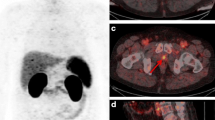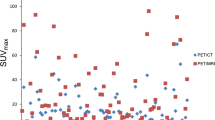Abstract
Purpose
The positron emission tomography (PET) tracer 68Ga-PSMA-11, targeting the prostate-specific membrane antigen (PSMA), is rapidly excreted into the urinary tract. This leads to significant radioactivity in the bladder, which may limit the PET-detection of local recurrence (LR) of prostate cancer (PC) after radical prostatectomy (RP), developing in close proximity to the bladder. Here, we analyze if there is additional value of multi-parametric magnetic resonance imaging (mpMRI) compared to the 68Ga-PSMA-11-PET-component of PET/CT or PET/MRI to detect LR.
Methods
One hundred and nineteen patients with biochemical recurrence after prior RP underwent both hybrid 68Ga-PSMA-11-PET/CTlow-dose (1 h p.i.) and -PET/MRI (2-3 h p.i.) including a mpMRI protocol of the prostatic bed. The comparison of both methods was restricted to the abdomen with focus on LR (McNemar). Bladder-LR distance and recurrence size were measured in axial T2w-TSE. A logistic regression was performed to determine the influence of these variables on detectability in 68Ga-PSMA-11-PET. Standardized-uptake-value (SUVmean) quantification of LR was performed.
Results
There were 93/119 patients that had at least one pathologic finding. In addition, 18/119 Patients (15.1%) were diagnosed with a LR in mpMRI of PET/MRI but only nine were PET-positive in PET/CT and PET/MRI. This mismatch was statistically significant (p = 0.004). Detection of LR using the PET-component was significantly influenced by proximity to the bladder (p = 0.028). The PET-pattern of LR-uptake was classified into three types (1): separated from bladder; (2): fuses with bladder, and (3): obliterated by bladder). The size of LRs did not affect PET-detectability (p = 0.84), mean size was 1.7 ± 0.69 cm long axis, 1.2 ± 0.46 cm short-axis. SUVmean in nine men was 8.7 ± 3.7 (PET/CT) and 7.0 ± 4.2 (PET/MRI) but could not be quantified in the remaining nine cases (obliterated by bladder).
Conclusion
The present study demonstrates additional value of hybrid 68Ga-PSMA-11-PET/MRI by gaining complementary diagnostic information compared to the 68Ga-PSMA-11-PET/CTlow-dose for patients with LR of PC.





Similar content being viewed by others
Abbreviations
- ADT:
-
Androgen deprivation therapy
- BCR:
-
Biochemical recurrence
- CT:
-
Computed tomography
- DCE:
-
Dynamic contrast-enhanced imaging
- DWI:
-
Diffusion-weighted imaging
- GS:
-
Gleason score
- LR:
-
Local recurrence
- MRI:
-
Magnetic resonance imaging
- mpMRI:
-
Multiparametric MRI
- PC:
-
Prostate cancer
- PET:
-
Positron emission tomography
- RP:
-
Radical prostatectomy
- RT:
-
Radiotherapy
- SUV:
-
Standard uptake value
- 68Ga:
-
Gallium-68
- PSMA:
-
Prostate-specific membrane antigen
- 18F-FECH:
-
Fluorethylcholine
- 18F-FDG:
-
2 − 18F-fluoro-2-deoxy-D-glucose
References
Mottet N, Bellmunt J, Briers E, Bolla M, Cornford P, De Santis M, et al. Guidelines on prostate cancer. Eur Assoc Urol. 2016;53:68–80.
Stephenson AJ, Scardino PT, Eastham JA, Bianco FJ, Dotan ZA, Fearn PA, et al. Preoperative nomogram predicting the 10-year probability of prostate cancer recurrence after radical prostatectomy. J Natl Cancer Inst. 2006;98:715–7.
Fossati N, Karnes RJ, Boorjian SA, Moschini M, Morlacco A, Bossi A, et al. Long-term Impact of Adjuvant Versus Early Salvage Radiation Therapy in pT3N0 Prostate Cancer Patients Treated with Radical Prostatectomy : Results from a Multi-institutional Series. Eur. Urol. Eur Assoc Urol; 2016;1–8.
Pfitzenmaier J, Pahernik S, Tremmel T, Haferkamp A, Buse S, Hohenfellner M. Positive surgical margins after radical prostatectomy: do they have an impact on biochemical or clinical progression? BJU Int. 2008;102:1413–8.
Eder M, Schäfer M, Bauder-Wüst U, Hull WE, Wängler C, Mier W, et al. 68Ga-complex lipophilicity and the targeting property of a urea-based PSMA inhibitor for PET imaging. Bioconjug Chem. 2012;23:688–97.
Afshar-Oromieh A, Haberkorn U, Eder M, Eisenhut M, Zechmann C. [68Ga]Gallium-labelled PSMA ligand as superior PET tracer for the diagnosis of prostate cancer: comparison with 18F-FECH. Eur J Nucl Med Mol Imaging. 2012;39:1085–6.
Sachpekidis C, Kopka K, Eder M, Hadaschik BA, Freitag MT, Pan L, et al. 68Ga-PSMA-11 dynamic PET/CT imaging in primary prostate cancer. Clin Nucl Med. 2016;41:e473–9.
Freitag MT, Radtke JP, Hadaschik BA, Kopp-Schneider A, Eder M, Kopka K, et al. Comparison of hybrid 68Ga-PSMA PET/MRI and 68Ga-PSMA PET/CT in the evaluation of lymph node and bone metastases of prostate cancer. Eur J Nucl Med Mol Imaging. 2015;43:70–83.
Afshar-Oromieh A, Malcher A, Eder M, Eisenhut M, Linhart HG, Hadaschik BA, et al. PET imaging with a [68Ga]gallium-labelled PSMA ligand for the diagnosis of prostate cancer: biodistribution in humans and first evaluation of tumour lesions. Eur J Nucl Med Mol Imaging. 2013;40:486–95.
Afshar-Oromieh A, Avtzi E, Giesel FL, Holland-Letz T, Linhart HG, Eder M, et al. The diagnostic value of PET/CT imaging with the 68Ga-labelled PSMA ligand HBED-CC in the diagnosis of recurrent prostate cancer. Eur. J. Nucl. Med. Mol. Imaging. 2014;1–13.
Eiber M, Maurer T, Souvatzoglou M, Beer AJ, Ruffani A, Haller B, et al. Evaluation of hybrid 68Ga-PSMA-ligand PET/CT in 248 patients with biochemical recurrence after radical prostatectomy. J Nucl Med. 2015;56:668–74.
Rauscher I, Maurer T, Fendler WP, Sommer WH, Schwaiger M, Eiber M. (68)Ga-PSMA ligand PET/CT in patients with prostate cancer: How we review and report. Cancer Imaging Off Publ Int Cancer Imaging Soc. 2016;16:14.
Rauscher I, Maurer T, Beer AJ, Graner F-P, Haller B, Weirich G, et al. Value of 68Ga-PSMA HBED-CC PET for the assessment of lymph node metastases in prostate cancer patients with biochemical recurrence: comparison with histopathology after salvage lymphadenectomy. J. Nucl. Med. Off. Publ. Soc. Nucl. Med. 2016
Perera M, Papa N, Christidis D, Wetherell D, Hofman MS, Murphy DG, et al. Sensitivity, Specificity, and Predictors of Positive 68Ga–Prostate-specific Membrane Antigen Positron Emission Tomography in Advanced Prostate Cancer: A Systematic Review and Meta-analysis. Eur. Urol. [Internet]. 2016 [cited 2016 Jun 29]; Available from: Perera M, Papa N, Christidis D, Wetherell D, Hofman MS, Murphy DG, et al. Sensitivity, Specificity, and Predictors of Positive 68Ga–Prostate-specific Membrane Antigen Positron Emission Tomography in Advanced Prostate Cancer: A Systematic Review and Meta-analysis. Eur. Urol. [Internet]. 2016 [cited 2016 Jun 29]; Available from: http://linkinghub.elsevier.com/retrieve/pii/S0302283816302937
Afshar-Oromieh A, Zechmann CM, Malcher A, Eder M, Eisenhut M, Linhart HG, et al. Comparison of PET imaging with a 68Ga-labelled PSMA ligand and 18F-choline-based PET/CT for the diagnosis of recurrent prostate cancer. Eur J Nucl Med Mol Imaging. 2014;41:11–20.
Roman-Jimenez G, Crevoisier RD, Leseur J, Devillers A, Ospina JD, Simon A, et al. Detection of bladder metabolic artifacts in 18F-FDG PET imaging. Comput Biol Med. 2016;71:77–85.
Linder BJ, Kawashima A, Woodrum DA, Tollefson MK, Karnes J, Davis BJ, et al. Early localization of recurrent prostate cancer after prostatectomy by endorectal coil magnetic resonance imaging. Can J Urol. 2014;21:7283–9.
Barchetti F, Panebianco V. Multiparametric MRI for Recurrent Prostate Cancer Post Radical Prostatectomy and Postradiation Therapy. BioMed Res Int. 2014;2014:1–23.
Panebianco V, Barchetti F, Sciarra A, Musio D, Forte V, Gentile V, et al. Prostate cancer recurrence after radical prostatectomy: the role of 3-T diffusion imaging in multi-parametric magnetic resonance imaging. Eur Radiol. 2013;23:1745–52.
Park JJ, Kim CK, Park SY, Park BK, Lee HM, Cho SW. Prostate Cancer: Role of Pretreatment Multiparametric 3-T MRI in Predicting Biochemical Recurrence After Radical Prostatectomy. Am J Roentgenol. 2014;202:W459–65.
Kitajima K, Hartman RP, Froemming AT, Hagen CE, Takahashi N, Kawashima A. Detection of Local Recurrence of Prostate Cancer After Radical Prostatectomy Using Endorectal Coil MRI at 3 T: Addition of DWI and Dynamic Contrast Enhancement to T2-Weighted MRI. Am J Roentgenol. 2015;205:807–16.
Heusser T, Mann P, Schäfer M, Dimitrakopoulou-Strauss A, Kachelrieß M, Schlemmer H-P, et al. The Halo-Artifact in 68Ga-PSMA-PET/MRI: Studies Using Phantom and Clinical Data. 5th PSMR Conf. PETMR SPECTMR. 2016.
Heidenreich A, Bastian PJ, Bellmunt J, Bolla M, Joniau S, van der Kwast T, et al. EAU guidelines on prostate cancer. Part II: Treatment of advanced, relapsing, and castration-resistant prostate cancer. Eur Urol. 2014;65:467–79.
Afshar-Oromieh A, Haberkorn U, Schlemmer HP, Fenchel M, Eder M, Eisenhut M, et al. Comparison of PET/CT and PET/MRI hybrid systems using a 68Ga-labelled PSMA ligand for the diagnosis of recurrent prostate cancer: initial experience. Eur J Nucl Med Mol Imaging. 2014;41:887–97.
Roy C, Foudi F, Charton J, Jung M, Lang H, Saussine C, et al. Comparative Sensitivities of Functional MRI Sequences in Detection of Local Recurrence of Prostate Carcinoma After Radical Prostatectomy or External-Beam Radiotherapy. Am J Roentgenol. 2013;200:W361–8.
Carbone SF, Pirtoli L, Ricci V, Carfagno T, Tini P, La Penna A, et al. Diffusion-Weighted Magnetic Resonance Diagnosis of Local Recurrences of Prostate Cancer after Radical Prostatectomy: Preliminary Evaluation on Twenty-Seven Cases. BioMed Res Int. 2014;2014:1–8.
Lopes Dias J, Lucas R, Magalhães Pina J, João R, Costa NV, Leal C, et al. Post-treated prostate cancer: normal findings and signs of local relapse on multiparametric magnetic resonance imaging. Abdom Imaging. 2015;40:2814–38.
Couñago F, del Cerro E, Recio M, Díaz AA, Marcos FJ, Cerezo L, et al. Role of 3T multiparametric magnetic resonance imaging without endorectal coil in the detection of local recurrent prostate cancer after radical prostatectomy: the radiation oncology point of view. Scand J Urol. 2015;49:360–5.
Evangelista L, Cimitan M, Hodolič M, Baseric T, Fettich J, Borsatti E. The ability of 18F-choline PET/CT to identify local recurrence of prostate cancer. Abdom Imaging. 2015;40:3230–7.
Paparo F, Piccardo A, Bacigalupo L, Romagnoli A, Piccazzo R, Monticone M, et al. Value of bimodal 18F-choline-PET/MRI and trimodal 18F-choline-PET/MRI/TRUS for the assessment of prostate cancer recurrence after radiation therapy and radical prostatectomy. Abdom Imaging. 2015;40:1772–87.
Bluemel C, Krebs M, Polat B, Linke F, Eiber M, Samnick S, et al. 68Ga-PSMA-PET/CT in Patients With Biochemical Prostate Cancer Recurrence and Negative 18F-Choline-PET/CT. Clin Nucl Med. 2016;41:515–21.
Morigi JJ, Stricker PD, van Leeuwen PJ, Tang R, Ho B, Nguyen Q, et al. Prospective Comparison of 18F-Fluoromethylcholine Versus 68Ga-PSMA PET/CT in Prostate Cancer Patients Who Have Rising PSA After Curative Treatment and Are Being Considered for Targeted Therapy. J Nucl Med. 2015;56:1185–90.
Giesel FL, Cardinale J, Schäfer M, Neels O, Benešová M, Mier W, et al. (18)F-Labelled PSMA-1007 shows similarity in structure, biodistribution and tumour uptake to the theragnostic compound PSMA-617. Eur J Nucl Med Mol Imaging. 2016;43:1929–30.
Giesel FL, Fiedler H, Stefanova M, Sterzing F, Rius M, Kopka K, et al. PSMA PET/CT with Glu-urea-Lys-(Ahx)-[68Ga(HBED-CC)] versus 3D CT volumetric lymph node assessment in recurrent prostate cancer. Eur J Nucl Med Mol Imaging. 2015;42:1794–800.
Eiber M, Weirich G, Holzapfel K, Souvatzoglou M, Haller B, Rauscher I, et al. Simultaneous 68Ga-PSMA HBED-CC PET/MRI Improves the Localization of Primary Prostate Cancer. Eur. Urol. [Internet]. 2016 [cited 2016 Sep 18]; Available from: http://linkinghub.elsevier.com/retrieve/pii/S0302283816000117
Rouvière O, Vitry T, Lyonnet D. Imaging of prostate cancer local recurrences: why and how? Eur Radiol. 2010;20:1254–66.
Acknowledgements
We would like to express our gratitude to Dr. Stefan Kegel and the support of our technicians Regula Gnirs, Heike Streib-Retzbach, Julia Schliebus, Cora Weyrich, and Rene Hertel for their excellent support.
Author information
Authors and Affiliations
Corresponding author
Ethics declarations
Funding
There was no funding for this study.
Conflicts of interest
Heinz-Peter Schlemmer, Ali Afshar-Oromieh and Matthias C. Roethke have received honoraria from Siemens Healthcare for educational sessions. The other authors report no conflict of interest.
Informed consent
All procedures performed in studies involving human participants were in accordance with the ethical standards of the institutional and/or national research committee and with the 1964 Helsinki Declaration and its later amendments or comparable ethical standards. Informed consent was obtained from all individual participants included in the study.
Additional information
Martin T. Freitag and Jan P. Radtke contributed equally to this work.
Rights and permissions
About this article
Cite this article
Freitag, M.T., Radtke, J.P., Afshar-Oromieh, A. et al. Local recurrence of prostate cancer after radical prostatectomy is at risk to be missed in 68Ga-PSMA-11-PET of PET/CT and PET/MRI: comparison with mpMRI integrated in simultaneous PET/MRI. Eur J Nucl Med Mol Imaging 44, 776–787 (2017). https://doi.org/10.1007/s00259-016-3594-z
Received:
Accepted:
Published:
Issue Date:
DOI: https://doi.org/10.1007/s00259-016-3594-z




